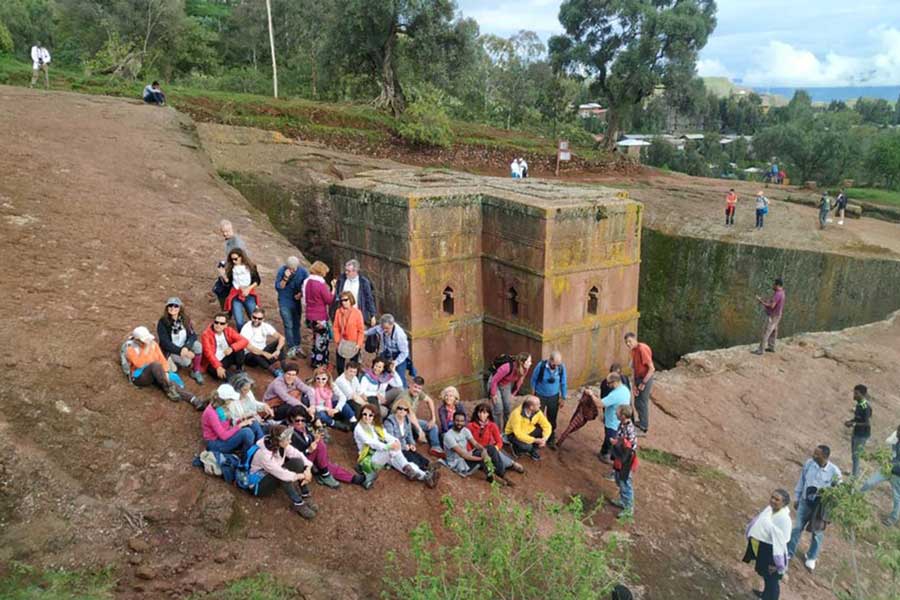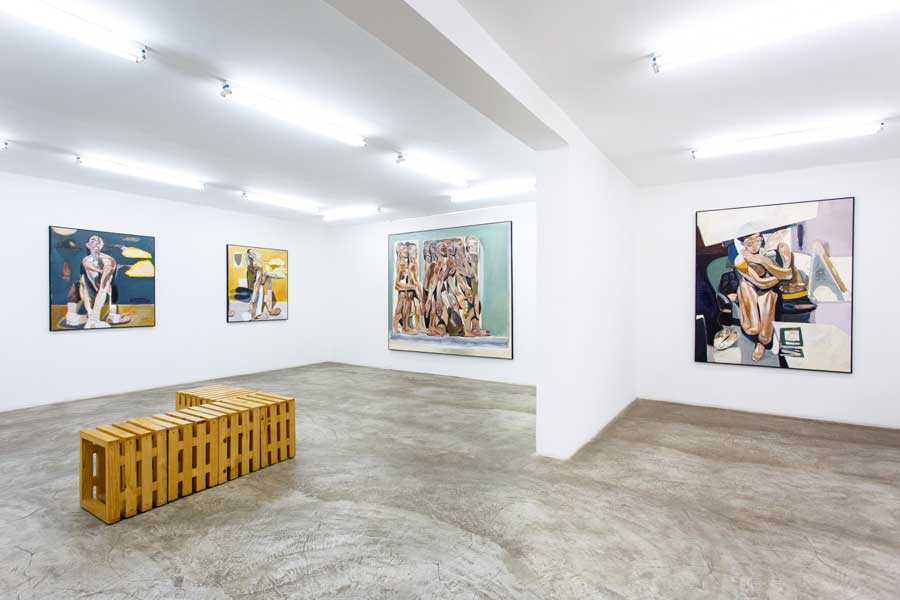
Editorial | Sep 02,2023
For years, I was intrigued by the imposing engraving on the stone walls at the heart of Meskel Square. Written the same in Amharic and English, the Addis Abeba Museum defies the norm of using the letter 'A' to spell the capital city.
But I never dared to climb the slab of stairs leading to the gate of the majestic mansion that stands out with prominent roof ornament visible from afar.
Little did I know, it was a window into Ethiopia's history and culture.
I finally decided to check it out one of the days last week, ascending the narrow spiral of stone stairways. A two-storey mansion behind a beautiful garden unfolded before me where the floor, steps, and walls were well-varnished hardwood with extensive glass windowpanes.
There is a short framed anecdote showing the mansion was built by a person named Hajji Qawas in the late 80s. It was originally a munition store and was later given to Ras Biru Woldegebriel and his wife Amakelech Ali as a wedding gift. The family lived in the mansion for many years and it was eventually transformed into a museum in 1974.
The old wooden floor echoed, as I entered the "Establishment" Hall. It exemplified the history of previous capitals from ancient Yeha and Axum to medieval Lalibela and Gonder to Ankober and Entoto and finally Addis Abeba, from its inception to the present day.
While the black and white photographs of Emperor Menelik II and Empress Taytu Bitul showcased the early settlements, the progress was felt through artefacts and paintings that provided historical accounts.
The next hall "Growth", displays facets of the expanding city's significant early developments. Modern shops and warehouses were constructed by Arab, Indian and Armenian merchants, which were considered grandiose by the standards of that era.
One of the most popular exhibits in the museum is the Adwa Hall. It showcases Ethiopia's victory over the Italian forces at the Battle of Adwa in 1896 through weapons, uniforms, and photographs. There is a painting that depicts the final showdown between the Ethiopian and Italian armies.
The portrait is a great representation of Adwa and deserves high praise for its vivid visualisation. Both sides used artillery while engaged in close-range combat, where the Ethiopian army used swords and spears and the Italians fired point-blank pistol shots.
The core of leadership has been preserved in a corner in the exhibit that is dedicated to the early days of Emperor Hailesellasie's reign and the refinements made in the banking systems and monetary history of the country. The display includes various currencies used, from salt bars to Maria Theresa's silver coins and modern banknotes with Emperor's image.
I was intrigued by how the fate of this ancient European royal family became intertwined with the Ethiopian Kingdom of the 20th century, leading to the Austrian currency being used as a local currency in Ethiopia.
I had the opportunity to visit the Schonbrunn Palace in Vienna, which was the seat of the Austro-Hungarian empire led by the Hoffsburg noble family. The Palace was a grand edifice with over 140 rooms and magnificent gardens spread over 400 acres of land.
This family is notable for producing the last queen of France, Marie Antoinette, who was married to Charles XVI of France. Unfortunately, her mother Maria Theresa's political gamble to strengthen European power and appease the old rival France ended tragically with Marie Antoinette being slain at the Guillotine during the French Revolution, as depicted in Charles Dickens's classic “A Tale of Two Cities.”
The next room was dedicated to the dark phase of history whereby the Italian colonial powers invaded and occupied Ethiopia from 1935 until 1941. The occupying Italian forces are shown parading the streets and the Viceroy General Rudolfo Grazziani is portrayed in photos taken in his military uniform on horseback.
The massacre in which close to a hundred thousand residents were slain en masse following a failed grenade-throwing assassination attempt on the Viceroy. Some grim photos show victims of the occupying forces after being brutally dragged on the streets on vehicles by ropes tied to their bodies. A bombshell lies on display as a grim reminder of the atrocities the Fascists committed during air raids with poisonous mustard gases resulting in numerous civilian death tolls.
I continued to the festive side where Addis Abeba celebrated its 100 years anniversary, inviting world leaders and showcasing gifts from various cities. I was particularly struck with an ostrich egg, encased in the embroidery of colourful beads and an ivory tusk propped and meshed within elegantly designed metallic frames.
I was a 11-year-old child when Addis Abeba celebrated its centenary and I recall my father taking us for fireworks at Lagare train station and Tikur Anbessa victory monuments. The fountains with panoramic lightwork played in rhythm were breathtaking for residents who never witnessed such sights before. I learned years later that they were built by the North Koreans.
The memorabilia highlights Addis Abeba's diplomatic prominence and history as a launch pad for African nations against colonial powers. It features photos of Emperor HaileSellasie, Gamal Abdel Nasir, Kwame Nkrumah, Jomo Kenyatta, Mengistu Hailemariam, Nelson Mandela, and Fidel Castro.
I proceeded with my tour upstairs, now used to the rather pleasant squeaking sound of the stairs as I trod into the rooms full of history and grandeur for the city I call home.
The mansion's mesmerising beauty is evident in the stairways leading to a balcony adorned with classic portraits. The first elegant work of art is an abstract watercolour by Ethiopian renowned woman painter Desta Hagos, called Composition. The painting is a kaleidoscope of light-coloured bubbles accentuated by dark-shaded rectangles with occasional bold and light lines.
Two paintings caught my attention with distinct and explicit meanings and colourful styles from the rest; they depict girls fetching water in a rural marketplace and elderly people attending a classroom to learn reading and writing.
The paintings are from the days of the Dergue regime when a nationwide campaign to eradicate adult illiteracy called "Meserete Timhirt" was undertaken.
Each household had a red pen card indicating all residents could read and write, while black indicated at least one person was illiterate. Officials were commissioned to audit and enforce class attendance, with classes held in Kebele offices.
The campaign was hailed by friends and foes as a success and earned recognition from UNESCO.
As a child, I remember adults attending mandatory evening classes in the city, where young housemaids and adult men studied. One farmer I am familiar with joined the class at 25 years old and later earned his doctorate degree in Agro Engineering.
The municipal history corner displays photographs of notable mayors of Addis Abeba, including writer-diplomat Blaten Geta Hiruy WeldeSellasie, general Dejazmatch Mesfin Sileshi, diplomat and academician Dejazmatch Zewdie GebreSellasie, longest-serving comrade Zewdie Teklu, reformist Arkebe Equabay and modern technocrat Berhane Deressa.
These photographs remind me of the Hamburger Rathaus, Germany's city hall, where the walls are adorned with historical figures. Giving due respect and chronicling those who laid their fingerprints on the city's history ensures its thriving and future progress.
I penned down my earnest appreciation in the visitors' log book and made my way to the garden outside, where the museum and exhibition centre are located. It offers a view of the city from St. Estifanos Church to Churchill Road, with the railway dissecting the square and beyond.
Stashed silently behind the seemingly quiet and desolate mansion of the museum lie its children who called it home and bled and toiled for its headway. The spirits and aspirations of the previous generation, manifested in the priceless treasures within its walls.
I feel guilty for waiting this long for a visit but it is better late than never. The Addis Abeba Museum is a fascinating place to learn about Ethiopia's rich history and culture, with exhibits that are well-curated and informative.
PUBLISHED ON
Aug 05,2023 [ VOL
24 , NO
1214]


Editorial | Sep 02,2023

My Opinion | Aug 22,2020

Fortune News | Oct 12,2019

Featured | Sep 06,2020

Radar | Dec 25,2023

Radar | Mar 05,2022

Radar | Feb 10,2024

Agenda | Nov 28,2020

View From Arada | Mar 27,2021

Viewpoints | Jan 04,2020

Dec 22 , 2024 . By TIZITA SHEWAFERAW
Charged with transforming colossal state-owned enterprises into modern and competitiv...

Aug 18 , 2024 . By AKSAH ITALO
Although predictable Yonas Zerihun's job in the ride-hailing service is not immune to...

Jul 28 , 2024 . By TIZITA SHEWAFERAW
Unhabitual, perhaps too many, Samuel Gebreyohannes, 38, used to occasionally enjoy a couple of beers at breakfast. However, he recently swit...

Jul 13 , 2024 . By AKSAH ITALO
Investors who rely on tractors, trucks, and field vehicles for commuting, transporting commodities, and f...

Jul 5 , 2025
Six years ago, Ethiopia was the darling of international liberal commentators. A year...

Jun 28 , 2025
Meseret Damtie, the assertive auditor general, has never been shy about naming names...

Jun 21 , 2025
A well-worn adage says, “Budget is not destiny, but it is direction.” Examining t...

Jun 14 , 2025
Yet again, the Horn of Africa is bracing for trouble. A region already frayed by wars...